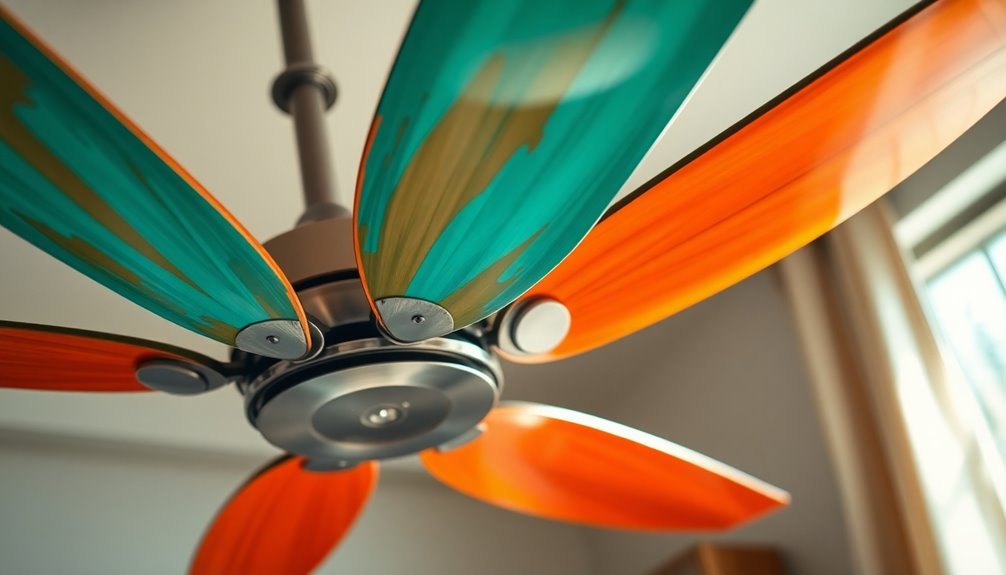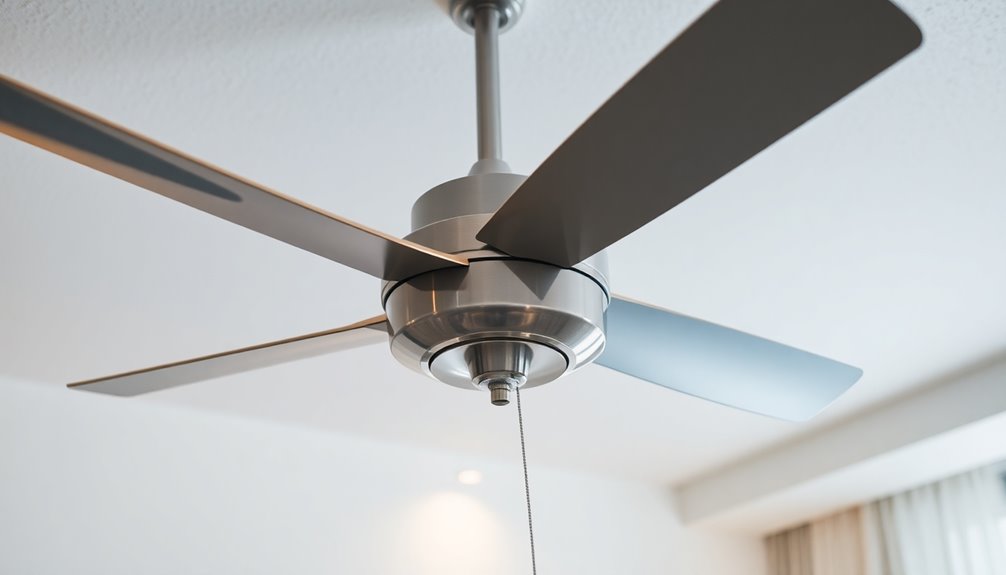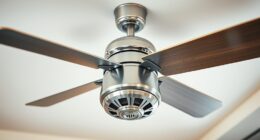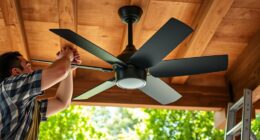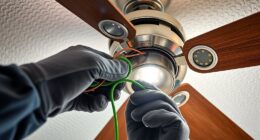Reversing your ceiling fan in winter creates an updraft that pushes warm air down from the ceiling, ensuring even heat distribution. This is especially helpful in rooms with high ceilings, where cold spots can form. You'll find that running the fan on a low setting prevents drafts while enhancing thermal comfort. Plus, it can save you 10-15% on heating costs by allowing you to lower your thermostat. Regular maintenance and ideal usage times make a difference too. Discover how to easily switch your fan's direction and explore more energy-efficient options to maximize your comfort.
Key Takeaways
- Reversing a ceiling fan in winter creates an updraft, pushing warm air down from the ceiling for improved heat distribution.
- This method enhances thermal comfort by eliminating cold spots and maintaining consistent room temperatures.
- It can lead to energy savings of 10-15% on heating costs by allowing lower thermostat settings.
- Improved heating system efficiency results from better warm air circulation, supporting effective indoor air quality.
- Regular maintenance and optimal fan selection enhance airflow and efficiency when operating in reverse mode.
Ceiling Fan Direction in Winter

When winter arrives and temperatures drop, knowing the right ceiling fan direction can make a big difference in your comfort. You should set your ceiling fan in reverse to rotate clockwise. This creates an updraft that pushes warm air, which naturally rises, back down towards your living space.
By adjusting the direction of the fan, you can effectively eliminate warm air stratification, ensuring a more even distribution of heat throughout the room. This is especially important in rooms with high ceilings, where heat can easily accumulate near the ceiling, leaving the floor chilly.
Running your ceiling fan in reverse mode can enhance thermal comfort and help your heating system work more efficiently. You might even notice a decrease in your energy bills, as you won't need to crank up the thermostat quite as high.
Most ceiling fans come equipped with a simple switch, making it easy for you to change the blade rotation direction for seasonal adjustments. So, don't forget to flip that switch when winter sets in to maximize your comfort and minimize your heating costs.
Benefits of Winter Mode

When you switch your ceiling fan to winter mode, you can enjoy greater thermal comfort in your home. By circulating warm air downwards, you'll feel warmer without cranking up the heat, which can save you money on energy bills. This simple adjustment can lead to energy cost reductions of up to 10-15%, making your space cozier and more efficient. Additionally, using a ceiling fan in winter can enhance the overall efficiency of your heating system by promoting better heat distribution throughout the room. Moreover, this method complements heat pump systems by allowing for even more effective heat management.
Energy Cost Reduction
A reversed ceiling fan can considerably lower your energy bills during winter. By redistributing warmer air that accumulates near the ceiling back down, you can save up to 10-15% on heating costs. When you operate your fan in reverse, you'll find that you can lower your thermostat settings, which reduces energy consumption while keeping your home comfortable.
Here's a quick overview of how reversing your ceiling fan helps with energy cost savings:
| Benefit | Description | Impact |
|---|---|---|
| Warm Air Distribution | Moves warmer air down to the living space | Reduces heating costs |
| Lower Thermostat | Allows for lower heating settings | Saves energy |
| Faster Room Heating | Enhances effectiveness of heating systems | Warmer rooms quicker |
| Eliminates Cold Spots | Reduces temperature stratification | Even room temperatures |
| Overall Savings | Contributes to long-term energy cost savings | More efficient heating |
Utilizing a ceiling fan in winter not only leads to significant energy cost savings but also creates a more balanced heating environment in your home.
Enhanced Thermal Comfort
Reversing your ceiling fan in winter not only saves on energy costs but also greatly enhances thermal comfort in your home.
By adjusting the direction of the blades to rotate clockwise, you can effectively circulate warm air that naturally rises to the ceiling, allowing it to flow down into the living space. This guarantees a cozy environment without relying heavily on your heating system.
Here are three key benefits of enhanced thermal comfort from reversing your ceiling fans:
- Even Temperature Distribution: The updraft created by the fan helps eliminate cold spots, maintaining a consistent temperature throughout the room.
- Improved Heating Efficiency: By pushing warm air downward, your existing heating system works more effectively, making rooms feel cozy faster.
- Lower Thermostat Settings: You can comfortably lower your thermostat by 3-5 degrees, which can help you save on heating costs by 10-15%. Additionally, using a ceiling fan in winter can complement air purifiers by ensuring that the warm air is evenly distributed, enhancing overall indoor air quality.
Energy Savings Potential

Reversing your ceiling fan in winter can greatly lower your heating costs while enhancing energy efficiency. By redistributing warm air and improving temperature distribution, you can enjoy a cozy home without cranking up the thermostat. This simple adjustment not only saves you money but also optimizes your heating system's performance. Additionally, the use of energy-efficient models can further enhance your savings and comfort. Furthermore, maintaining an organized environment can enhance your overall well-being by creating a sense of calm that complements the comfort of your home. Additionally, this practice can help reduce the reliance on heating and cooling systems, leading to further energy savings. Additionally, ensuring proper ventilation in your home can further support the effectiveness of your heating strategies.
Lower Heating Costs
Optimizing your home's heating efficiency can lead to substantial savings, especially during the colder months. By reversing your ceiling fan, you can greatly lower heating costs. This simple adjustment can save you up to 10-15% on your heating bills.
Here's how it works:
- Redistributes Warm Air: Warm air naturally rises and collects near the ceiling. Reversing your fan pushes this warm air back down, ensuring a consistent room temperature.
- Lower Thermostat Settings: With better air circulation, you can reduce your thermostat settings by 3-5 degrees without sacrificing comfort. This directly impacts your heating costs.
- Less Strain on HVAC Systems: Efficient air circulation reduces the workload on your heating system, leading to longer equipment life and fewer maintenance needs.
Enhanced Energy Efficiency
By utilizing a reversed ceiling fan during winter, you not only cut down on heating costs but also enhance your home's overall energy efficiency. This simple adjustment can lead to energy savings of 10-15% on heating costs. By redistributing warm air that rises to the ceiling, ceiling fans optimize heating efficiency and allow you to lower your thermostat settings by 3-5 degrees without sacrificing comfort. Additionally, incorporating commercial grade heat pumps can further improve your home's energy performance, as they can achieve efficiencies of 300-600%, maximizing the benefits of your heating system.
Here's a quick view of the benefits:
| Benefit | Impact |
|---|---|
| Energy Savings | 10-15% reduction in costs |
| Heating Efficiency | Faster room heating |
| Thermal Comfort | Balanced heat distribution |
Efficient air circulation from reversed ceiling fans not only improves thermal comfort by eliminating hot and cold spots but also reduces the strain on your heating system. This can extend its lifespan and decrease maintenance costs. Additionally, using energy-efficient models of heat pumps in conjunction with ceiling fans can significantly enhance overall energy management in your home. So, by making the switch to reverse mode, you're not just saving money; you're creating a more comfortable and energy-efficient home environment. Embrace the power of ceiling fans this winter!
Improved Temperature Distribution
There's a simple yet effective way to enhance your home's comfort during winter: using a ceiling fan in reverse. This action helps push warm air, which naturally rises and accumulates near the ceiling, downward, creating improved temperature distribution throughout your living space.
By doing this, you can eliminate cold spots and reduce the temperature difference between the floor and ceiling.
Here are three key benefits of reversing your ceiling fan:
- Energy Savings: You can save up to 10-15% on heating costs, allowing for lower thermostat settings while still maintaining warmth.
- Improved Air Circulation: The fan helps optimize the efficiency of existing heating systems, enabling them to heat spaces more effectively and quickly.
- Reduced Workload on HVAC Systems: By redistributing warm air, your heating system works less, contributing to a longer lifespan and lower maintenance costs.
Incorporating a ceiling fan in reverse not only enhances comfort but also promotes energy efficiency.
How to Change Direction

Wondering how to change your ceiling fan's direction for winter use? It's quite simple! Most ceiling fans come with a reverse switch located on the motor housing or on a wall control.
To change the direction, first make sure the fan is turned off to avoid any damage. Once it's off, flip the reverse switch to switch the blade rotation. This will allow the air to move in a way that helps you stay warm by circulating the warm air that gathers near the ceiling.
After you change the direction, run the fan on a low setting. This gentle airflow effectively pushes the warm air down without creating a draft, making your space more comfortable.
It's also a good idea to clean the fan blades before use to guarantee ideal airflow and efficiency.
Lastly, don't forget to regularly check that all components are secured before operating your ceiling fans. This guarantees safety and functionality, giving you peace of mind while you enjoy the cozy warmth of your home this winter!
Optimal Usage Times

After adjusting your ceiling fan for winter use, knowing when to operate it can enhance your comfort considerably.
Utilizing ceiling fans at ideal times can make a significant difference in your indoor environment. Here are three key moments to reflect on:
- During Sleep: Running your ceiling fan on a low setting while you sleep helps circulate warm air from the ceiling downwards, creating a cozy atmosphere for restful nights.
- While Dining: Turn on your ceiling fan during meals to improve air circulation. This not only makes the dining experience more enjoyable but also helps maintain a consistent temperature, enhancing overall comfort.
- Throughout the Day: Use ceiling fans when you're at home to promote room ventilation. This prevents stale air from accumulating and supports the efficiency of your heating systems.
In winter, it's essential to run your ceiling fan in a clockwise direction. This gentle rotation helps distribute warm air efficiently without causing uncomfortable downdrafts.
Choosing the Right Ceiling Fan

Choosing the right ceiling fan can greatly impact your comfort and energy efficiency during winter. When selecting a fan, consider longer blades; they move more air at lower speeds, helping create a warm environment.
Opt for a larger fan size, as it guarantees effective airflow, especially when you reverse the direction to push warm air down from the ceiling. If you're unsure, it's better to go for a larger model.
Make certain to install the ceiling fan at a height above 2.20 meters to promote ideal air circulation and safety. It's also essential to choose a fan compatible with your ceiling type, whether flat or sloped, to assure proper performance and ease of installation.
Regular maintenance is key to keeping your ceiling fan operating efficiently. Clean the blades and check the fixtures periodically to prolong its lifespan. Additionally, ensuring your fan is energy-efficient will further enhance heating effectiveness while minimizing costs.
Related Resources and Tips

For maximizing the benefits of your ceiling fan in winter, it's essential to tap into a few helpful resources and tips. By reversing the direction of a ceiling fan, you'll push warmer air down and improve comfort in your living space.
Here are three key tips to enhance your fan's performance:
- Switch the Blade Direction: Most fans have a simple switch to change the direction of the blades. Set it to rotate clockwise on low speed to minimize cool air drafts while distributing heat evenly.
- Regular Maintenance: Keep your fan blades clean and free of dust. Regular maintenance guarantees your fan runs efficiently in both winter and summer modes, maximizing energy savings.
- Monitor Heating Costs: With proper fan usage, you can save 10-15% on heating costs. Track your energy bills to see how adjusting your fan's settings contributes to a warmer and more comfortable home.
Frequently Asked Questions
Does Reversing the Ceiling Fan Make a Room Warmer?
Reversing your ceiling fan can actually make a room feel warmer.
When you switch it to rotate clockwise, it pushes the warm air that's gathered near the ceiling down towards you. This circulation helps create a more even temperature throughout the space, eliminating cold drafts.
You might even find that you can lower your thermostat a few degrees while still staying comfortable.
What Is the Purpose of Reversing a Ceiling Fan?
Imagine cozying up in a blanket as a gentle breeze stirs around you.
Reversing a ceiling fan serves to enhance your comfort by adjusting airflow, creating an updraft that redistributes warm air.
This simple switch helps eliminate cold spots in your room and keeps the temperature more consistent.
Plus, it can save you money on energy bills by allowing you to lower your thermostat.
Which Direction Should the Ceiling Fan Go in Winter?
In winter, your ceiling fan should rotate clockwise. This direction pushes warm air down from the ceiling, helping to create a more comfortable atmosphere in your room.
As you watch the blades move to the right, you'll notice they create an updraft, circulating warmth effectively. By using this setting, you can maintain an even temperature and potentially lower your heating costs.
Make sure to flip the switch on your fan to reverse the blade direction!
What Does Winter Mode on a Ceiling Fan Do?
When you switch your ceiling fan to winter mode, it rotates clockwise, creating an updraft that pushes warm air back down.
This circulation eliminates cold spots and makes your room feel cozier without drafts.
You'll notice improved efficiency from your heating system, and you might even lower your thermostat setting.
Plus, using winter mode can cut heating costs by up to 10%.
It's an easy way to stay comfortable and save energy.
Conclusion
In winter, reversing your ceiling fan can boost comfort and save energy. Did you know that using your fan in the winter can cut heating costs by up to 15%? By circulating warm air that rises to the ceiling, you create a cozy environment without cranking up the thermostat. So, don't forget to switch your fan direction and enjoy those energy savings! Embrace this simple change, and you'll feel the difference in your space all winter long.

